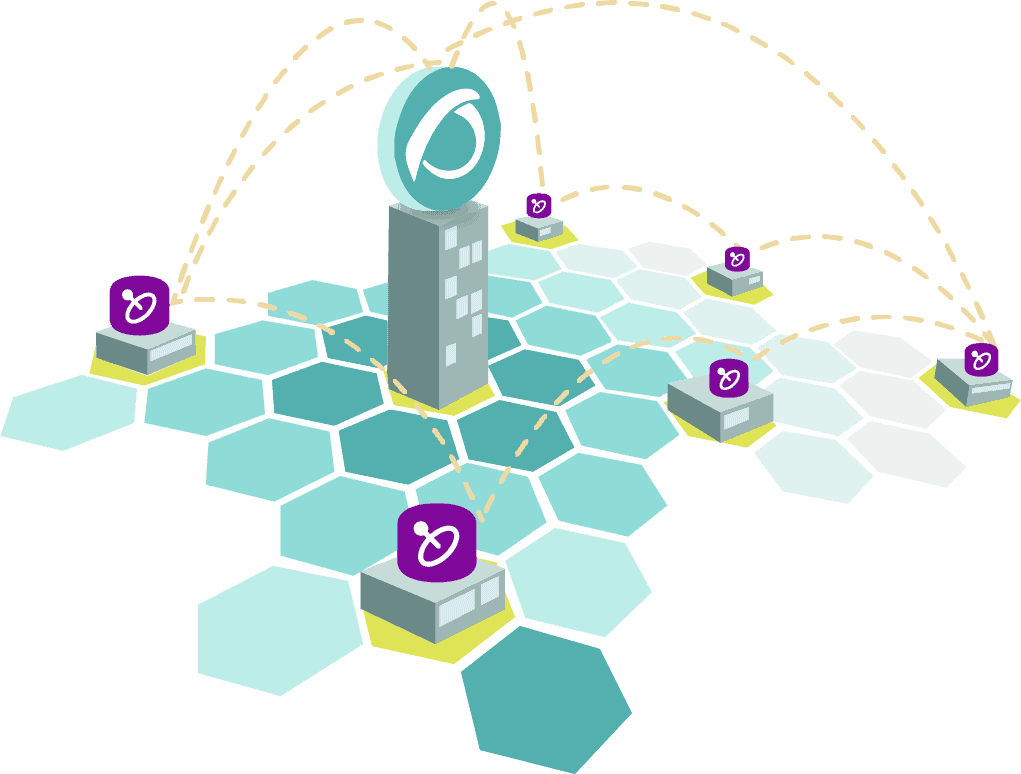Satellite server in remote environment monitoring
Today we will talk about one of the most versatile elements that Pandora FMS Enterprise offers us for monitoring distributed environments, the Satellite server. It will allow you to monitor different networks remotely, without the need to have connectivity directly from the monitoring environment with the computers that make it up. We will describe the typical case of companies that have central headquarters and remote offices, the different things we may find and how the satellite server can help us deploy efficient monitoring in an economic, fast and simple way.
Standard monitoring types
Before getting into the description of the case, let’s remember how monitoring works overall with Pandora FMS. There are two basic types of monitoring, local monitoring and remote monitoring.
The first, which we call local, consists of installing a small software on your devices (servers, mobiles, workstations, etc.) which we call monitoring agent. Agents are in charge of collecting the metrics locally on the machine, packaging them and sending them to the server. In this type of monitoring, communication goes from the agent (monitored device) to the server in a defined time interval, so the server does not have to interrogate the device, it just has an open port through which information is received, and any device that can reach that port will be able to send its data, so communication is “simple”, you just need to make sure that your monitoring server is exposed to all of your agents.

The second form of monitoring is what we call remote monitoring. Remote monitoring means that the monitoring server interrogates the agent to monitor through some protocol (icmp, tcp, snmp, http, wmi, etc). This could go from a simple ping to connecting to the api of a complex tool, such as vsphere, to retrieve information from all virtual machines, esx and datastores running in this environment and their corresponding metrics.
This type of monitoring opens the doors to being able to retrieve large amounts of data requiring little configuration and without the need to install any extra software on the devices, which is wonderful, but it also entails other inconveniences, such as having to guarantee connectivity from the monitoring server to each of the elements to be monitored, taking into account the security criteria to open these communications.

When you have a single headquarters of any size, this is not usually a problem, since you might usually have your devices and applications concentrated in the same place and communications management between environments is usually easier, this situation becomes complicated when you have more than one headquarters or small remote offices.
Description of a distributed environment
Let’s picture a distributed architecture with a headquarters where you have most of your applications and IT equipment, but you also have smaller sites that also have their equipment and applications. We have examples of this infrastructure, highly distributed, in environments like restaurant franchises, supermarkets, banks, retail stores, pharmacies, insurance companies, etc. Where they usually have powerful, well-managed data centers at headquarters, but remote sites lack the space or staff to maintain servers. Most of the time, there are not even permanent technical support staff for the equipment in these locations, so implementing monitoring can be challenging.
If some technology is implemented such as a site-to-site vpn, a sd-wan or dedicated communication between your sites, there is hardly any problem, you may have your monitoring environment at your headquarters and from there “attack” your remote devices. Well, the problem is that these solutions are expensive and require implementation and management, and if they are not already implemented, their implementation can become very complicated (and expensive). It is in these cases where the satellite server becomes essential, since it combines the versatility of remote monitoring with the communication behavior of local monitoring.
Using the Satellite Server
The Satellite Server consists of software that will be in charge of doing the remote checks on your network. Let’s say that in our restaurant, for example, it will do network scans, monitor each of the restaurant’s devices through different protocols, store these data and then pack them and send them to the main Pandora FMS server as if it were a local agent, so the headquarters/remote headquarters communication is simplified. You just have to make sure that a single device, the Satellite Server, can communicate with Pandora FMS server, in that sense from the remote headquarters to the main headquarters to send the data packets. Remote checks will always be done from within the local network without the need to expose any of the services, devices or applications of your remote headquarters.

Even if you want to make use of hybrid monitoring (local and remote monitoring) in your remote headquarters, you may install software agents on your devices and point them to our satellite so that it becomes the single delivery point between your remote headquarters and your headquarters.
In addition, the Satellite Server has remote configuration, so once deployed, it can be managed and configured from your main monitoring environment, being able to add new metrics, alert systems, policies and more configurations without having to access your remote headquarters, all from your Pandora FMS web console at your headquarters.
Regarding its deployment, the Satellite Server is a very light software especially compared to a full Pandora FMS installation, so the hardware requirements for monitoring remote sites are really low, it can even be deployed in a Raspberry Pi, which is a very cheap and compact device, or failing that, you may use any of the resources that are already deployed at the headquarters, such as a data server, to deploy your Satellite.
As you can see, monitoring remote sites using the satellite server simplifies a huge deal the configuration necessary for monitoring, helping you save money and implementation time that without a tool like this would be a lot higher and more complex.
Today we discussed only one of the typical cases, which is one of the most common ones, to describe the performance and the usefulness of a satellite server, but it is not only valid for remote locations, it is useful in many other ways, such as load balancing, making checks at the same point from different locations (very useful in monitoring web pages) or even for monitoring complex environments such as Kubernetes or Openshift, where many of the services are not exposed to the outside, such as databases or backend services, and that you could monitor if you deployed a pod with the satellite within the network and directly attacking these services, for example.
If you want to learn more about the Satellite Server feature, how to install and configure it, or want to find out more Pandora FMS specific features, stay tuned to our blog and do not hesitate to visit our youtube channel, where you may find tutorials, workshops and a lot of content devoted to this and many other topics related to monitoring.

Project Manager at Pandora FMS. More than 15 years of experience in the IT world. Lover of technology and open source, DevOps culture. Fan and promoter of automation, containerization and container orchestration. Project manager in Pandora FMS. More than 15 years of experience in the IT world. Technology and open source lover, DevOps culture. Fan and promoter of the automation, containment and orchestration of containers.


















